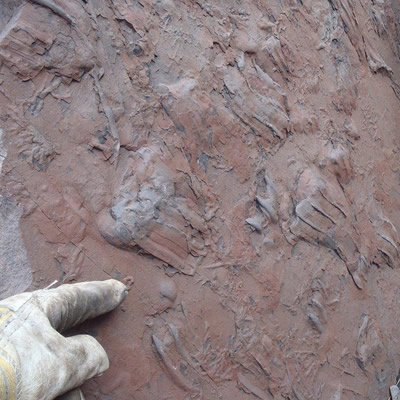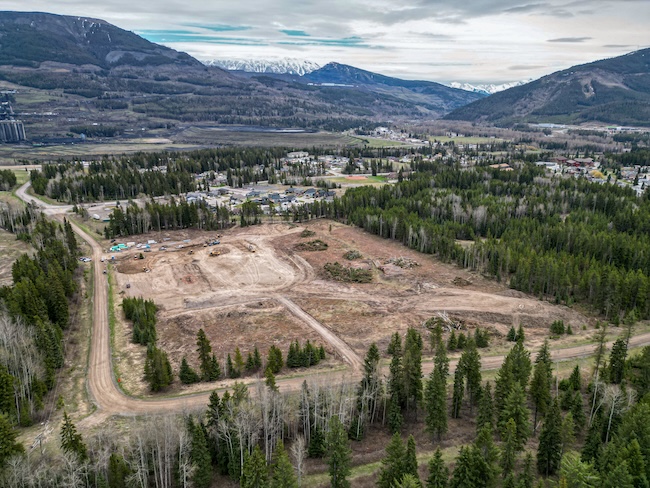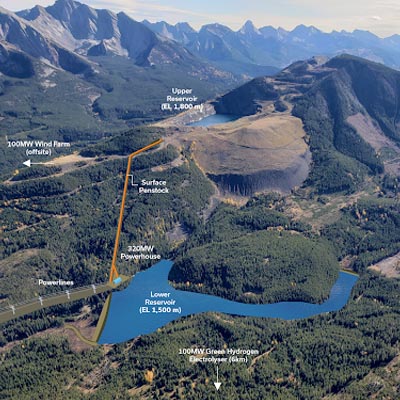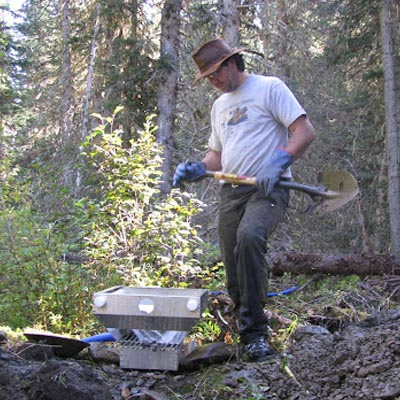Tumbler Ridge, British Columbia—not your typical mining town

The crocodilian track slab Kevin Sharman identified while working at Teck Resources' Quintette Mine. — Photo courtesy Kevin Sharman At first glance,
The crocodilian track slab Kevin Sharman identified while working at Teck Resources' Quintette Mine. — Photo courtesy Kevin Sharman
At first glance, Tumbler Ridge seems like a typical mining town riding the waves of the industry. Its story, however, is unique. Most interestingly, this small British Columbia mining town is now home to a recognized UNESCO geopark. Through the discovery of dinosaur fossils, the townspeople, miners and paleontologists have learned to work together to optimize the region’s natural space and economy.
The town of Tumbler Ridge is young in comparison to other mining towns—it was only incorporated in 1981. Paving the road into town and building the infrastructure of Tumbler Ridge was a megaproject of the provincial government at the same time that private enterprise was opening the first coal mines following the discovery of vast amounts of coal.
Kevin Sharman has been a geologist in the area since the mid eighties, following the freshly paved road alongside thousands of other workers at the beginning of the first wave of mining in Tumbler Ridge. “I moved here in 1984. Houses were up, streets were paved,” he said. Before 1981, the area was typically only visited by trappers, resource explorers and transient First Nations people.
Sharman rode the waves of the mining town, earning his retirement a few years ago. In the early 2000s, Tumbler Ridge experienced its first economic sag as mining operations halted at the Quintette and Bullmoose mines. The original mines in the area were victims of low coal prices, according to Sharman, with one mine closing before its scheduled completion date.
“It is hard to watch your friends move away in these ups and downs,” Sharman said. The town experienced a third wave of mining activity in 2016. Despite the mine closures, many people chose to keep their homes in Tumbler Ridge. “We’re a bit special in that people really want to live here even if the mines aren’t working,” Sharman said.
However, as the first mines closed, two children discovered the first fossilized dinosaur footprints. The organic diversification of the town could not have come at a better time.
Eventually, UNESCO recognized the area as the Tumbler Ridge Global Geopark. This status allows the town and its industries to live simultaneously with the natural heritage in the area. “Geoparks encourage people to reconnect to the landscape and interact with the earth on every different level,” said Sarah Waters, executive director of the geopark, “whether it’s experiencing biodiversity or cultural heritage or natural heritage.” The town of Tumbler Ridge balances industry, daily life and a respect for the natural heritage of Northeastern British Columbia.
The second life of the mines began in 2004 and lasted until 2014—just as Tumbler Ridge was exploring the natural heritage of the area. Over this time, the coal mines have learned to work with the geopark to preserve the natural heritage of Tumbler Ridge. From UNESCO’s perspective, sustainable mining practices are acceptable in geoparks. The geopark and the town “would not exist without coal,” said Sarah Waters. “Through coal we’ve identified several unique fossils and large trackways.”
When footprints or suspected fossils are identified on site, miners call the local museum to document them as soon as possible. “It has led to a positive relationship,” said Waters. “The coal industry feels good about what they’ve done, but they can continue their work without being financially affected.” For example, Sharman is personally responsible for the discovery of large crocodilian slabs while working at the mines—a discovery that was immediately documented and preserved by the museum, further demonstrating their harmonious relationship.
It was the children—now adults—of the town’s family physician, Charles Helm, who first stumbled across the dinosaur tracks. Funnily enough, Helm’s other passion is the history of mining in Tumbler Ridge and the local historian has published three books on the topic.
“We have really passionate people here,” Helm said of his neighbours. “The whole idea is to work together. In other places, you have turf wars.” Turf wars don’t exist in Tumbler Ridge. “There’s enough space here that we respect other groups and work with them. That same co-operation is true for industry. People work together here,” Helm said.
Tumbler Ridge’s unique perspective on industry, diversification and neighbourly camaraderie is probably the reason the town has already survived three mining waves. “We’ve gone from being the successful one-industry town to almost a ghost town, and now working on these other diversification strategies,” Helm said. “The bottom line is that we are still here. Other mining towns are truly ghost towns.”
As expected in the energy sector, Tumbler Ridge will probably endure more waves of work and the lack thereof in its future. But through the co-operation of intertwined industries and neighbours, this small town has set itself up for success.
Learn more at the Tumbler Ridge Museum Foundation
The Tumbler Ridge Museum Foundation has a couple of branches where visitors can learn more. The Dinosaur Discovery Gallery is where visitors take in interactive theatre presentations along with recreated and enhanced dinosaur exhibits. The Peace Region Palaeontology Research Centre houses the dinosaur fossils and bones of Tumbler Ridge. The Museum Foundation also features exhibits on the human history of the area.
Many fossils and points of interest are found directly in the geopark. Guided tours are available of the dinosaur trackways.
The Tumbler Ridge Museum Foundation has a couple of branches where visitors can learn more. The Dinosaur Discovery Gallery is where visitors take in interactive theatre presentations along with recreated and enhanced dinosaur exhibits. The Peace Region Palaeontology Research Centre houses the dinosaur fossils and bones of Tumbler Ridge. The Museum Foundation also features exhibits on the human history of the area.
Many fossils and points of interest are found directly in the geopark. Guided tours are available of the dinosaur trackways.




